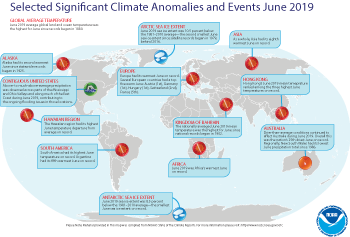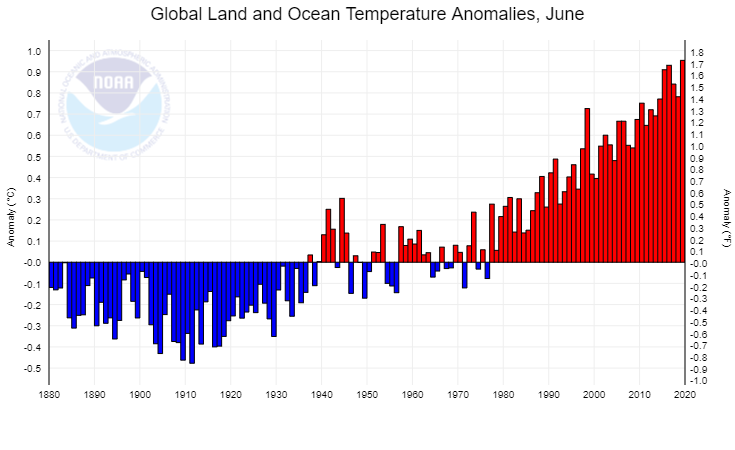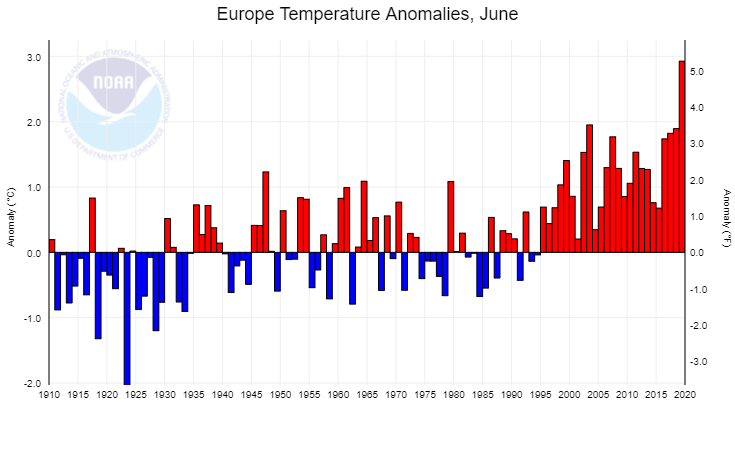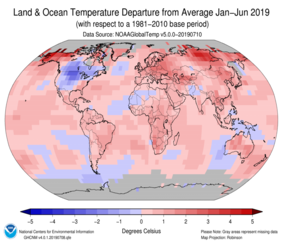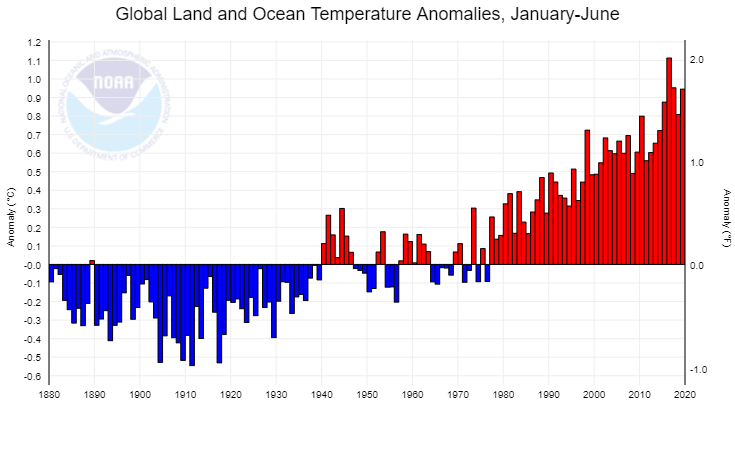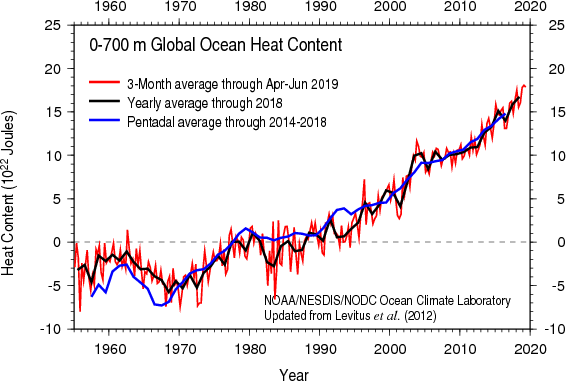Introduction
PLEASE NOTE: With the May 2019 global report and data release, the National Centers for Environmental Information transitioned to an improved version of NOAA's Global Temperature data set (NOAAGlobalTemp version 5), which includes the updated versions of its global land (GHCNm version 4.0.1) and ocean (ERSST version 5) data sets. Please note that anomalies and ranks reflect the historical record according to these updated versions. Historical months and years June differ from what was reported in previous years. Please visit our Commonly Asked Questions for additional information.
Temperature anomalies and percentiles are shown on the gridded maps below. The anomaly map on the left is a product of a merged land surface temperature (Global Historical Climatology Network, GHCN) and sea surface temperature (ERSST version 5) anomaly analysis. Temperature anomalies for land and ocean are analyzed separately and then merged to form the global analysis. For more information, please visit NCEI's Global Surface Temperature Anomalies page. The percentile map on the right provides additional information by placing the temperature anomaly observed for a specific place and time period into historical perspective, showing how the most current month, season or year compares with the past.
Temperature
In the atmosphere, 500-millibar height pressure anomalies correlate well with temperatures at the Earth's surface. The average position of the upper-level ridges of high pressure and troughs of low pressure—depicted by positive and negative 500-millibar height anomalies on the June 2019 map—is generally reflected by areas of positive and negative temperature anomalies at the surface, respectively.
June Temperature
The month of June was characterized by warmer-than-average temperatures across much of the world. The most notable warm June 2019 temperature departures from average were observed across central and eastern Europe, northern Russia, northeastern Canada, and southern parts of South America, where temperatures were 2.0°C (3.6°F) above the 1981–2010 average or higher. Record warm temperature departures from average during June 2019 were present across parts of central and eastern Europe, Asia, Africa, South America, the north Indian Ocean, and across parts of the Pacific and Atlantic oceans.
Meanwhile, the most notable cooler-than-average temperature departures from average were limited to parts of western Asia and Antarctica, where temperatures were at least 1.0°C (1.8°F) below the 1981–2010 average or cooler. According to the June 2019 percentiles map, cooler-than-average conditions were limited to parts of western Asia, Indonesia, across small areas in the Atlantic and North Pacific oceans, as well as the south-central contiguous United States. No land or ocean areas had record cold June temperatures.
Averaged as a whole, the June 2019 global land and ocean temperature departure from average was the highest for June since global records began in 1880 at +0.95°C (+1.71°F). This value bested the previous record set in 2016 by 0.02°C (0.04°F). Nine of the 10 warmest Junes have occurred since 2010. June 1998 is the only value from the previous century among the 10 warmest Junes on record, and it is currently ranked as the eighth warmest June on record. Junes 2015, 2016, and 2019 are the only Junes that have a global land and ocean temperature departure from average above +0.90°C (+1.62°F). June 2019 also marks the 43rd consecutive June and the 414th consecutive month with temperatures, at least nominally, above the 20th century average.
The global land-only surface temperature for June 2019 was 1.34°C (2.41°F) above the 20th century average. This was also the highest June temperature in the 140-year record, exceeding the previous record of +1.30°C (+2.34°F) set in 2015. According to NCEI's Regional Analysis, South America, Europe, Africa, the Hawaiian Region, and the Gulf of Mexico had their warmest June since regional records began in 1910. Asia and the Caribbean region had their eighth and ninth highest June temperature in the 110-year regional record, respectively. Meanwhile, North America and Oceania had their coolest (or least warm) June since 2009 and 2012, respectively.
The global ocean-only temperature for June 2019 tied with 2016 as the highest June temperature on record at 0.81°C (1.46°F) above average. Junes 2016 and 2019 are the only June global ocean-only temperature departures from average that have surpassed +0.80°C (+1.44°F). June 2019 tied with August 2015, April 2016, and June 2016 as the 10th highest monthly global ocean temperature departure from average among all months (1,674 months) on record. The 10 highest global ocean monthly temperature departures from average have all occurred since September 2015.
| Rank 1 = Warmest Period of Record: 1880–2019 |
Month + Year | Anomaly °C | Anomaly °F |
|---|---|---|---|
| 1 | January 2016 | 0.91 | 1.64 |
| 2 (tied) | October 2015 | 0.87 | 1.57 |
| 2 (tied) | November 2015 | 0.87 | 1.57 |
| 4 | March 2016 | 0.86 | 1.55 |
| 5 | December 2015 | 0.85 | 1.53 |
| 6 | September 2015 | 0.84 | 1.51 |
| 7 | February 2016 | 0.83 | 1.49 |
| 8 (tied) | July 2016 | 0.82 | 1.48 |
| 8 (tied) | August 2016 | 0.82 | 1.48 |
| 10 (tied) | August 2015 | 0.81 | 1.46 |
| 10 (tied) | April 2016 | 0.81 | 1.46 |
| 10 (tied) | June 2016 | 0.81 | 1.46 |
| 10 (tied) | June 2019 | 0.81 | 1.46 |
Select national information is highlighted below. Please note that different countries report anomalies with respect to different base periods. The information provided here is based directly upon these data:
- Europe had its warmest June on record at 2.93°C (5.27°F) above the 1910–2000 average, surpassing the previous record of 1.95°C (3.51°F) set in 2003 by +0.98°C (+1.76°F). June 2019 also marked the first time since continental records began in 1910 that Europe's June temperature departure from average surpassed the +2.0°C (+3.6°F) mark and nearly reaching +3.0°C (+5.4°F). Compared to all months, the June 2019 temperature departure from average tied with March 2017 as the 12th highest in the 1,314 monthly record. During the last week of June, an intense heat wave affected much of Europe, bringing temperatures that were 6.0°–10.0°C (10.8°–18.0°F) above average and resulting in numerous new records set.
- According to Spain's State Meteorological Agency, 29 stations registered new June maximum temperatures, with five of those stations setting a new all-time temperature record. Of note, the station at the Zaragoza airport had a maximum temperature of 43.2°C (109.8°F) on 29 June 2019, surpassing the previous June record of 41.0°C (105.8°F) set on 21 June 1965. Ten stations had a new high minimum temperature record for June. Of interest, Toledo's minimum temperature on 30 June 2019 only dropped to 25.0°C (77.0°F). This value was only 0.2°C (0.4°F) higher than the previous record set on 27 June 2012.
- France's nationally averaged June temperature was 20.1°C (68.2°F), which is 1.8°C (3.2°F) above average and the fifth highest June temperature on record. The nation's warmest June took place in 2003 with a temperature departure from average at +4.1°C (+7.4°F). Five of France's six warmest Junes have occurred since 2003, with June 1976 (third warmest June on record) the only year from the 20th century among the six warmest Junes on record. During the 25–30 June heat wave, France set a new national high maximum temperature when temperatures soared to 45.9°C (114.6°F) at Gallargues-le-Montueux in Gard. This value is 1.8°C (3.2°F) higher than the previous record of 44.1°C (111.4°F) set in August 2003 at the same location. This was also the first time temperatures surpassed 45.0°C (113.0°F) in France. According to Météo France, 60% of the agency's stations either equaled or exceeded their monthly record during the heat wave, with 23% of those stations surpassing the station's all-time record.
- Germany had its warmest June on record with a temperature departure from average of +4.4°C (+7.9°F). This value bested the previous record set in 2003 by 0.4°C (0.7°F). Germany also set a new national June maximum temperature record when temperatures reached 39.6°C (103.3°F) on June 30. According to Deutscher Wetterdienst, over 240 stations set new June temperature records and over 220 of those stations had a temperature of 35.0°C (95.0°F) or higher.
- Switzerland had its second warmest June (tied with 2017) on record, with a national temperature of 15.2°C (59.4°F). Switzerland's warmest June took place in 2003 (17.3°C / 63.1°F). According to Meteo Suisse, 43 of 85 stations in Switzerland set a new temperature record for June.
- The Czech Republic also set a new national maximum temperature for June. The temperature of 38.9°C (102.0°F) was set on 26 June 2019 in Doksany.
- Hungary had its warmest June on record.
- De Bilt, Netherlands had its highest June temperature since records began in 1901 at 18.1°C (64.6°F). This value was only 0.1°C (0.2°F) higher than the previous record set in 1976 and again in 2017.
- Austria had its warmest June since national records began in 1767 at 4.7°C (8.5°F) above average. The previous record was set in 2003 (+4.1°C / +7.4°F). The nation set a new record for the number of tropical nights (minimum temperature > 20.0°C [68.0°F]). According to ZAMG, there were 13 tropical nights at the Vienna Inner City station, surpassing by 1 day the previous record of 12 days set in 2003. In addition, 147 of 269 weather stations in Austria set new June temperature records, with 27 of those stations setting new all-time records.
- Hong Kong's June 2019 mean temperature of 29.0°C (84.2°F) was 1.1°C (2.0°F) above average and ranked among the three highest June temperatures on record.
- The Kingdom of Bahrain's June 2019 mean temperature of 36.3°C (97.3°F) was 3.9°C (7.0°F) above average and was the warmest June since national records began in 1902. This value beat the previous record of 35.7°C (96.3°F) set in 2018 by 0.6°C (1.1°F). The nation's maximum and minimum temperature were record and near-record warm for the month. According to the nation's Ministry of Transportation and Telecommunications, Bahrain had 20 days with maximum temperatures above 40.0°C (104.0°F), setting a new record. The previous record was 17 days set in 2006 and again in 2009.
- Argentina's June 2019 national temperature was 1.5°C (2.7°F) above the 1981–2010 average and was the fifth highest June temperature since national records began in 1961. Several provinces in northeastern Argentina had a top 10 warm June, with Misiones having its warmest June on record.
El Niño continued across the tropical Pacific Ocean during June 2019. According to NOAA's Climate Prediction Center, a transition to ENSO-neutral is expected in the next month or two. This forecast focuses on the ocean surface temperatures between 5°N and 5°S latitude and 170°W to 120°W longitude, called the Niño 3.4 region.
| June | Anomaly | Rank (out of 140 years) | Records | ||||
|---|---|---|---|---|---|---|---|
| °C | °F | Year(s) | °C | °F | |||
| Global | |||||||
| Land | +1.34 ± 0.16 | +2.41 ± 0.29 | Warmest | 1st | 2019 | +1.34 | +2.41 |
| Coolest | 140th | 1907 | -0.65 | -1.17 | |||
| Ocean | +0.81 ± 0.14 | +1.46 ± 0.25 | Warmest | 1st | 2016, 2019 | +0.81 | +1.46 |
| Coolest | 140th | 1911 | -0.49 | -0.88 | |||
| Ties: 2016 | |||||||
| Land and Ocean | +0.95 ± 0.14 | +1.71 ± 0.25 | Warmest | 1st | 2019 | +0.95 | +1.71 |
| Coolest | 140th | 1911 | -0.48 | -0.86 | |||
| Northern Hemisphere | |||||||
| Land | +1.37 ± 0.19 | +2.47 ± 0.34 | Warmest | 3rd | 2012 | +1.50 | +2.70 |
| Coolest | 138th | 1907 | -0.77 | -1.39 | |||
| Ocean | +1.01 ± 0.14 | +1.82 ± 0.25 | Warmest | 1st | 2019 | +1.01 | +1.82 |
| Coolest | 140th | 1904, 1913 | -0.52 | -0.94 | |||
| Land and Ocean | +1.15 ± 0.15 | +2.07 ± 0.27 | Warmest | 1st | 2019 | +1.15 | +2.07 |
| Coolest | 140th | 1909 | -0.49 | -0.88 | |||
| Southern Hemisphere | |||||||
| Land | +1.26 ± 0.12 | +2.27 ± 0.22 | Warmest | 2nd | 2015 | +1.31 | +2.36 |
| Coolest | 139th | 1911 | -1.07 | -1.93 | |||
| Ocean | +0.66 ± 0.15 | +1.19 ± 0.27 | Warmest | 2nd | 2016 | +0.71 | +1.28 |
| Coolest | 139th | 1911 | -0.51 | -0.92 | |||
| Land and Ocean | +0.76 ± 0.15 | +1.37 ± 0.27 | Warmest | 1st | 2019 | +0.76 | +1.37 |
| Coolest | 140th | 1911 | -0.60 | -1.08 | |||
| Arctic | |||||||
| Land and Ocean | +1.73 ± 0.22 | +3.11 ± 0.40 | Warmest | 3rd | 2016 | +2.02 | +3.64 |
| Coolest | 138th | 1886 | -1.42 | -2.56 | |||
The most current data can be accessed via the Global Surface Temperature Anomalies page.
Year-to-date Temperature
The average global land and ocean surface temperature during the first half of the year tied with 2017 as the second highest January–June period in the 140-year record at 0.95°C (1.71°F) above the 20th century average. January–June 2016 was warmer at +1.11°C (+2.00°F). According to NCEI's global annual temperature ranking outlook, it is virtually certain that 2019 will end among the top five warm years.
During the year-to-date, the most notable warm temperature departures from average were present across parts of the Northern Hemisphere, specifically Alaska, western Canada, and central Russia, where temperature departures from average were +3.0°C (+5.4°F) or higher. Record-warm January–June temperatures were present across central South America, the southern half of Africa, New Zealand and its surrounding ocean, as well as parts of Alaska, western Canada, Mexico, the Bering Sea, the Atlantic Ocean, Madagascar and surrounding Indian Ocean, and across parts of eastern Asia.
The most notable cool temperature departures from average were present across much of the contiguous U.S. and southern Canada, where temperatures were at least 1.0°C (1.8°F) below average or cooler. No land or ocean areas were record cold for the January–June period.
Averaged as a whole, the global land-only temperature for the year-to-date was 1.49°C (2.68°F) above average and the third highest in the 140-year record. Only 2016 and 2017 were warmer. The global ocean-only temperature for January–June 2019 was the second warmest on record at 0.74°C (1.33°F) above average, trailing behind 2016 by 0.1°C (0.2°F).
Regionally, five of six continents had a January–June temperature that ranked among the four highest such period on record, with South America having its warmest year-to-date on record. Oceania had a near-record January-June temperature.
Select national information is highlighted below. Please note that different countries report anomalies with respect to different base periods. The information provided here is based directly upon these data:
- Australia had its second warmest January–June period since national temperature records began in 1910.
- Hong Kong had its warmest January–June period on record for mean, maximum, and minimum temperatures.
| January–June | Anomaly | Rank (out of 140 years) | Records | ||||
|---|---|---|---|---|---|---|---|
| °C | °F | Year(s) | °C | °F | |||
| Global | |||||||
| Land | +1.49 ± 0.16 | +2.68 ± 0.29 | Warmest | 3rd | 2016 | +1.86 | +3.35 |
| Coolest | 138th | 1893 | -0.85 | -1.53 | |||
| Ocean | +0.74 ± 0.17 | +1.33 ± 0.31 | Warmest | 2nd | 2016 | +0.84 | +1.51 |
| Coolest | 139th | 1904, 1911 | -0.50 | -0.90 | |||
| Land and Ocean | +0.95 ± 0.17 | +1.71 ± 0.31 | Warmest | 2nd | 2016 | +1.11 | +2.00 |
| Coolest | 139th | 1911 | -0.55 | -0.99 | |||
| Ties: 2017 | |||||||
| Northern Hemisphere | |||||||
| Land | +1.54 ± 0.20 | +2.77 ± 0.36 | Warmest | 4th | 2016 | +2.09 | +3.76 |
| Coolest | 137th | 1893 | -0.96 | -1.73 | |||
| Ocean | +0.85 ± 0.16 | +1.53 ± 0.29 | Warmest | 2nd | 2016 | +0.94 | +1.69 |
| Coolest | 139th | 1904 | -0.52 | -0.94 | |||
| Land and Ocean | +1.11 ± 0.17 | +2.00 ± 0.31 | Warmest | 3rd | 2016 | +1.38 | +2.48 |
| Coolest | 138th | 1893 | -0.63 | -1.13 | |||
| Southern Hemisphere | |||||||
| Land | +1.35 ± 0.14 | +2.43 ± 0.25 | Warmest | 1st | 2019 | +1.35 | +2.43 |
| Coolest | 140th | 1917 | -0.90 | -1.62 | |||
| Ocean | +0.67 ± 0.17 | +1.21 ± 0.31 | Warmest | 3rd | 2016 | +0.76 | +1.37 |
| Coolest | 138th | 1911 | -0.52 | -0.94 | |||
| Land and Ocean | +0.78 ± 0.17 | +1.40 ± 0.31 | Warmest | 2nd | 2016 | +0.84 | +1.51 |
| Coolest | 139th | 1911 | -0.55 | -0.99 | |||
| Arctic | |||||||
| Land and Ocean | +2.49 ± 0.25 | +4.48 ± 0.45 | Warmest | 2nd | 2016 | +2.92 | +5.26 |
| Coolest | 139th | 1902 | -1.61 | -2.90 | |||
Precipitation
June Precipitation
The maps shown above represent precipitation percent of normal (left, using a base period of 1961–1990) and precipitation percentiles (right, using the period of record) based on the GHCN dataset of land surface stations. As is typical, precipitation anomalies during June 2019 varied significantly around the world. June precipitation was generally drier than normal across the southern and western Alaska, the western half of the contiguous U.S., parts of Mexico, northeastern Brazil, Paraguay, northern Chile, northwestern Argentina, central and eastern Europe, northern and southern Africa, Australia, and northeastern Russia, and parts of India. Wetter-than-normal conditions were notable across Canada, the eastern half of the contiguous, northeastern and southern Argentina, northern and southeastern Europe, central Russia, Japan, parts of China and northeastern Africa.
Select national information is highlighted below. (Please note that different countries report anomalies with respect to different base periods. The information provided here is based directly upon these data):
- June 2019 was a dry month for Spain. During the month, Spain's precipitation total was only 18 mm (0.71 inch), which is 58% of normal June precipitation. This was Spain's seventh driest June since national records began in 1965.
- The United Kingdom had above-average precipitation during June 2019 at 152% of normal. Regionally, England had its eighth wettest June (177% of normal) since records began in 1910, while Wales had its fourth wettest June (185% of normal) on record.
- Australia had a drier-than-average June at 31% below the nation's 1961–1990 average, resulting in the 25th driest June in the nation's 120-year record. Regionally, Victoria and Tasmania were the only Australian states that had near-average June precipitation. The Northern Territory had the highest precipitation deficit for the month, receiving only 0.5 mm (0.02 inch) or 93% below average during June 2019. However, Northern Territory June 2019 precipitation total ranked as the 28th driest June since precipitation record records began in 1900. New South Wales had its lowest precipitation total since 1986 at 19.7 mm (0.8 inch) or 49% below average.
Ocean Heat Content
Ocean Heat Content (OHC) is essential for understanding and modeling global climate since > 90% of excess heat in the Earth's system is absorbed by the ocean. Further, expansion due to increased ocean heat contributes to sea level rise. Change in OHC is calculated from the difference of observed temperature profiles from the long-term mean.
| Basin | 0-700 meters | Rank (1955-2023) | |||||
|---|---|---|---|---|---|---|
| Entire Basin | Northern Hemisphere | Southern Hemisphere | ||||
| Atlantic | 7.106 | 5th | 3.973 | 4th | 3.133 | 6th |
| Indian | 3.513 | 4th | 0.707 | 7th | 2.806 | 4th |
| Pacific | 6.896 | 3rd | 3.406 | 4th | 3.490 | 5th |
| World | 17.516 | 4th | 8.086 | 5th | 9.430 | 4th |
| Source: Basin time series of heat content | ||||||
Global OHC for April–June 2019 was the highest April–June OHC, as well as the second highest quarterly OHC, in our records, which extend back to 1955. Overall, the latest quarterly OHC reveals widespread warmer than normal, i.e. the 1955–2006 mean, conditions, a situation observed since the end of 2016. As has been the case since April–June 2018, warmer than normal conditions, about 10x105 J/m3, occupy the equatorial Pacific Ocean, except west of 170E. In the tropical and subtropical western Pacific Ocean, in contrast, cooler than normal conditions exist, with the cool signal extending northeastward from the Philippines in the subtropical western and central North Pacific Ocean. As in the previous quarter, much higher, > 30x105 J/m3, than normal OHC conditions are observed in the Gulf of Mexico, the Gulf Stream/North Atlantic Current, the Kuroshio Current/Kuroshio Extension, and along the northern Antarctic Circumpolar Current in the Indian Ocean. Warmer than normal conditions appear in the Greenland, Norwegian, and Barents Seas. Cooler than normal conditions persist in the subpolar North Atlantic Ocean south of Greenland and Iceland, and along the central Antarctic Circumpolar Current in the Pacific Ocean sector.
References
- Menne, M. J., C. N. Williams, B.E. Gleason, J. J Rennie, and J. H. Lawrimore, 2018: The Global Historical Climatology Network Monthly Temperature Dataset, Version 4. J. Climate, in press. https://doi.org/10.1175/JCLI-D-18-0094.1.
- Huang, B., Peter W. Thorne, et. al, 2017: Extended Reconstructed Sea Surface Temperature version 5 (ERSSTv5), Upgrades, validations, and intercomparisons. J. Climate, doi: 10.1175/JCLI-D-16-0836.1
- Peterson, T.C. and R.S. Vose, 1997: An Overview of the Global Historical Climatology Network Database. Bull. Amer. Meteorol. Soc., 78, 2837-2849.
- Huang, B., V.F. Banzon, E. Freeman, J. Lawrimore, W. Liu, T.C. Peterson, T.M. Smith, P.W. Thorne, S.D. Woodruff, and H-M. Zhang, 2016: Extended Reconstructed Sea Surface Temperature Version 4 (ERSST.v4). Part I: Upgrades and Intercomparisons. J. Climate, 28, 911-930.
 NOAA's National Centers for Environmental Information
NOAA's National Centers for Environmental Information
